Lincoln Airplane and Flying School and the Lincoln Standard Aircraft Company, Inc.
Introduction
Text-to-speech Audio
The Lincoln Standard Aircraft Company and the Lincoln Airplane and Flying School were two pillars of aviation development in Lincoln. But these institutions were really only made possible after other companies faltered.
Founded soon after World War I, the Nebraska Aircraft Company was one of the first major aircraft corporations in Lincoln. Owners A.G. Hebb, L.A. Winship, and E.C. Hammond bought an entire stock of WWI-surplus airplanes and some engines in an effort to create a powerful yet reliable airplane. The first of these airplanes was manufactured in the Industrial Arts Building on the old Nebraska State Fairgrounds. By 1921, the businessmen fell behind on their loan payments. One rumor suggests that one of the founders fled to Mexico with the company's assets.
Left to pick up the pieces, creditors turned to a local Buick salesman Ray Page to take over the company. Less than a decade later, Page and his colleagues turned the Lincoln Standard Aircraft Company into a truly national and international manufacturer of iconic airplanes.
Images
"Photograph taken at the Lincoln Airplane and Flying School in Lincoln, Nebraska. One pilot shows his trickery by flying upside down."
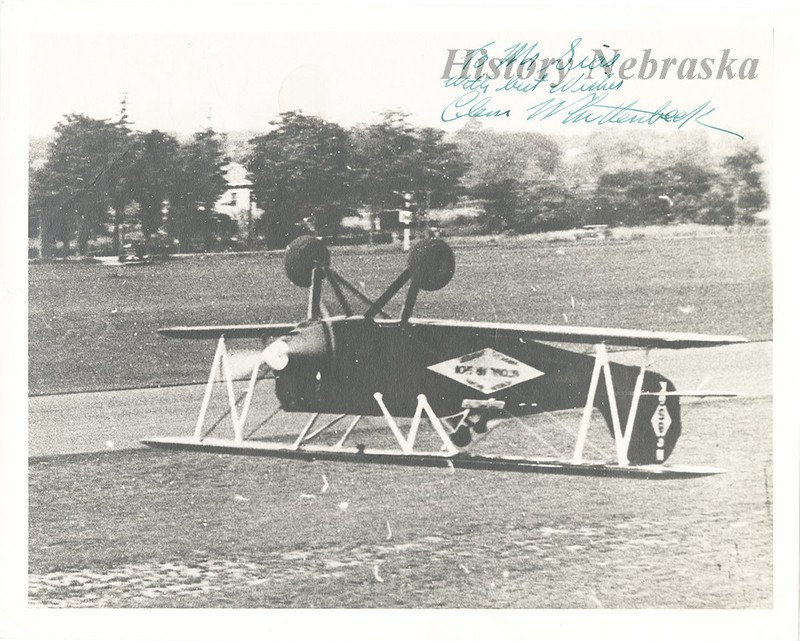
"Class photograph of the student cadets at the Lincoln Airplane and Flying School in Lincoln, Nebraska," c.1941
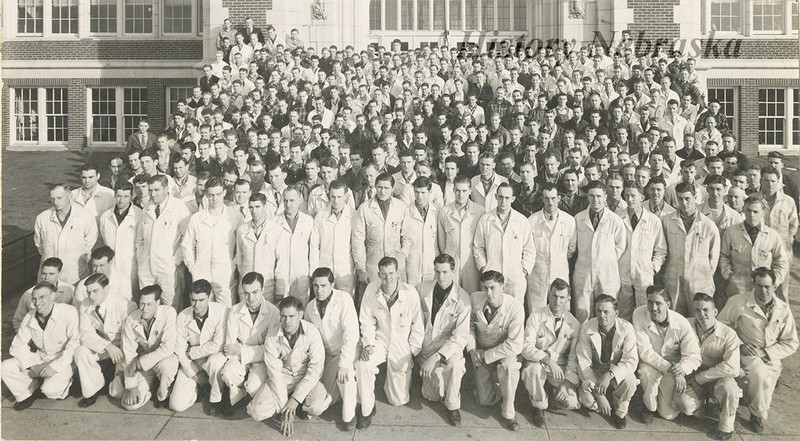
" Dance room party for the cadets at the Lincoln Airplane and Flying School in Lincoln, Nebraska. Performing on stage is Leo J. Beck and his orchestra," c.1940
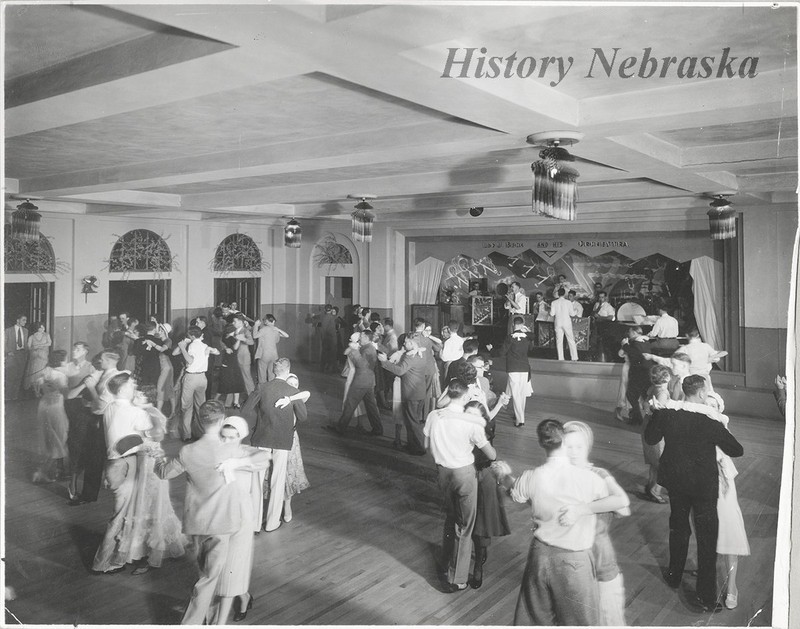
"Photograph taken of two female cadets at the Lincoln Airplane and Flying School in Lincoln, Nebraska," c.1940
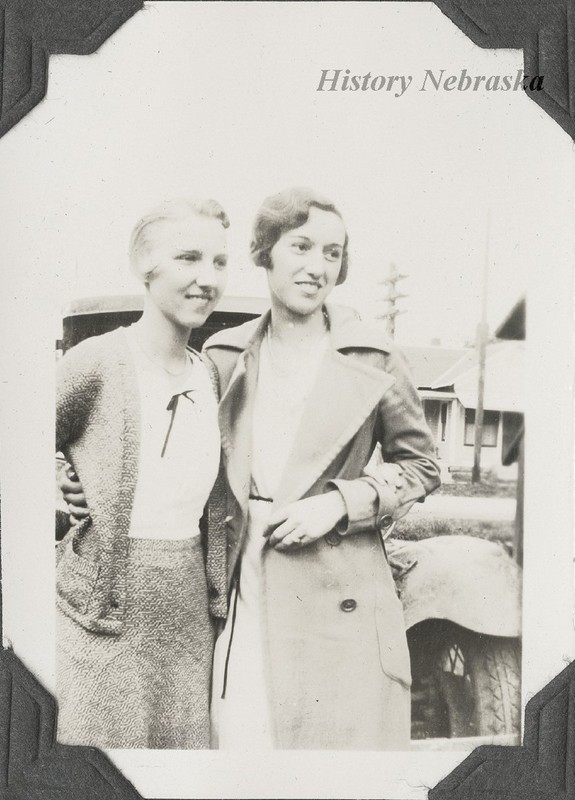
Single-engine, two-seat biplane aircraft built by the Nebraska Aircraft Corporation in Lincoln, later known as the Lincoln Standard Aircraft Company; Courtesy of the National Air and Space Museum
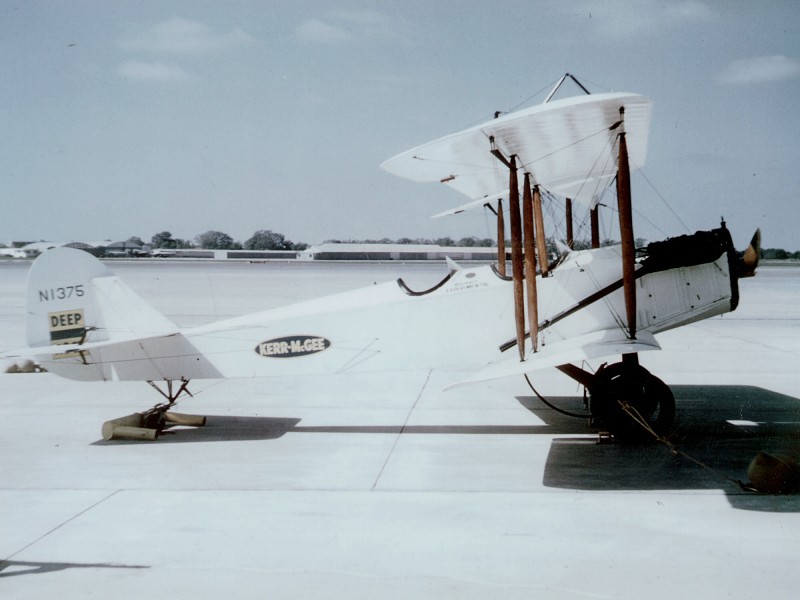
Planes sit at the airfield for the Lincoln Airplane and Flying School. The advertisement on the plane's tail reads, "Link Up with Lincoln."
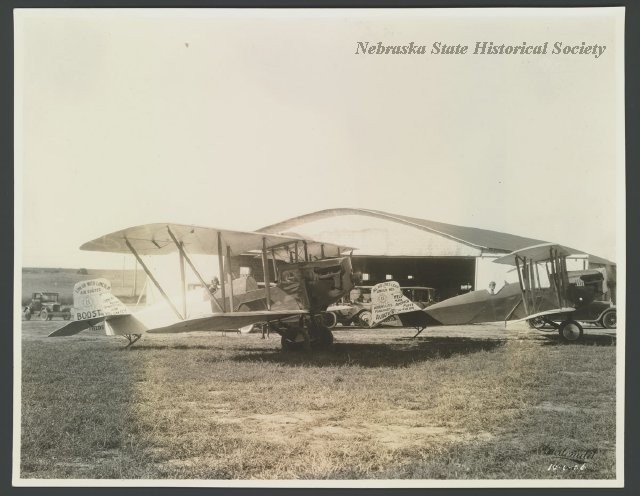
"Learn to Fly" advertisement for the Lincoln Airplane and Flying School, 1928.
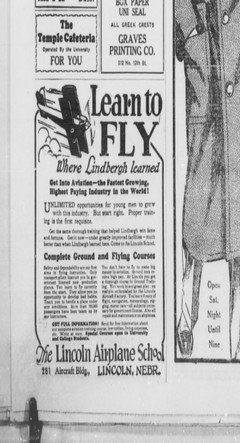
Rendering of the Lincoln Standard Aircraft Company, Inc.
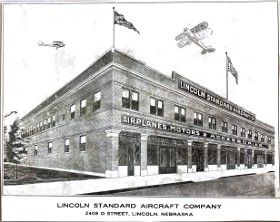
Backstory and Context
Text-to-speech Audio
After the financial debacles at the Nebraska Aviation Corporation, creditors tapped a local Buick salesman, Ray Page, to take control of the company. Page subsequently renamed it Lincoln Standard Aircraft Company with offices at 2409 'O' Street in Lincoln.
Some of the individuals helped Ray Page at the Lincoln Standard Aircraft Company include:
- Chief engineer, Otto Timm
- Built and designed planes since 1910
- Came to Lincoln in 1921 to do design work for Lincoln Aircraft
- Piloted the plane in which Bud Gurney and Charles Lindbergh took their first airplane ride in April 1922
- Test pilot, salesman, and stunt pilot: Eyer Sloniger
- Studied at UNL and began barnstorming part-time after training in France during WWI and at Kelly Field in Texas
- Had a close call with the Dole race in 1927
- Plant manager: Encil Chambers
- World War I veteran Encil Chambers broke the world record for a high-altitude parachute jump in 1921 when he leaped from 26,800 feet over Kansas City
In 1927, Ray Page expanded the administration of Lincoln Standard to include Victor Roos of Omaha, formerly an executive with Swallow Aircraft Corporation in Wichita, KS
A series of planes manufactured by Lincoln Standard became quite popular
- The Swallow-turned-Lincoln Page 3 (LP-3)
- Page Trainer (PT)
- Lincoln Sport: billed as the “world’s smallest practical airplane” (RG2801-1-53a&b)
As a result, Page and his partners molded Lincoln Standard Aircraft into a truly global airplane produces, selling aircrafts as far as Tucson, Arizona, and Honduras in Central America.
In the middle of Lincoln Standard's success, Ray Page sold the schooling portion of the company to E.J. Sias. Originally called the Lincoln Auto and Airplane School, it was later renamed the Lincoln Airplane and Flying School or, more formally, the Lincoln Aeoronautical Institute.
Like the Arrow Aircraft Company, the economic devastation of the Great Depression sunk sales. The company was forced to merge with American Eagle of KC in 1931. The Lincoln-based plant was closed soon thereafter.
\\\\\\
Nebraska Aircraft Corporation – a main competitor of Harding, Zook, and Bahl – was created by three businessmen in 1919. In an effort to create powerful yet reliant planes, the owners purchase a large stockpile of WWI-surplus airplanes and engines. The first of these airplanes was manufactured in the Industrial Arts Building on the old Nebraska State Fairgrounds. By 1921, the businessmen fell behind on their loan payments. Rumor suggests that one of the founders fled to Mexico with the company's assets. Consequently, creditors tapped a local salesman, Ray Page, to take control of the company in 1922 - renaming it Lincoln Standard Aircraft Company. In addition to producing planes, Lincoln Standard also provided flying lessons. Its most famous student was Charles Lindbergh, who enrolled at the school in 1922 and first learned to fly, parachute, and barnstorm in Lincoln. Later in the decade, the schooling branch of Lincoln Standard was purchased by E.J. Sias, who re-named it the Lincoln Airplane and Flying School while Lincoln Standard remained under the supervision of Page. On March 30, 1930, the Lincoln Airplane and Flying School was officially approved by the US Department of Commerce: Aeronautics Branch. The Lincoln Airplane and Flying School operated out of two locations: the recently constructed municipal airport housed the flight training program, while mechanics training took place at the company’s headquarters in downtown Lincoln at 2409 ‘O’ Street). The school briefly provided flight instruction to army cadets in 1939, before the Army Air Corps, “deterred by a particularly harsh Nebraska winter,” opted to move the training program to Lakeland, Florida, the following fall. The facility closed in 1945, but the mantle of flight instruction in Lincoln was quickly taken up by other aviation-minded entrepreneurs. Page sold Lincoln Standard in 1929 to a group of Omaha investors. Unfortunately, the Great Depression compounded the increase in government flying regulations prompted the company to move operations out of Lincoln to Kansas City.
Sources
Goeres, Vince. Kinley, Kylie . Wings Over Nebraska: Historic Aviation Photographs. Lincoln, NE. Nebraska State Historical Society Books, 2010.
Archive Record: RG3726.AM: Encil Chambers, 1895-1979, History Nebraska. Accessed July 15th 2021. https://nebraskahistory.pastperfectonline.com/archive/9434C81B-F6ED-4028-A4B5-612837894440.
Branting, Rob. Early Aviation in Lincoln, Nebraska, Lincoln Air Force Base Legacy Project. Accessed July 15th 2021. https://www.lincolnafb.org/history.php.
Archive Record: RG1163 Lincoln Aircraft Company, Inc. (Lincoln, Neb.), History Nebraska. Accessed July 15th 2021. https://nebraskahistory.pastperfectonline.com/archive/CAA6EE9D-36AE-4EFE-A05F-341405531020.
Archive Record: RG2153.AM: Lincoln Aviation Institute (Lincoln, Nebraska), History Nebraska. Accessed July 15th 2021. https://nebraskahistory.pastperfectonline.com/archive/D3D227C9-5941-4440-8B50-735229842005.
Archive Record: RG1108 Sias, Ernest J., 1877-1955, History Nebraska. Accessed July 15th 2021. https://nebraskahistory.pastperfectonline.com/archive/FAB92A61-BBDB-425A-9B34-391029164911.
Archive Record: RG1475.AM: Lincoln Airplane and Flying School (Lincoln, Nebraska), History Nebraska. Accessed July 15th 2021. https://nebraskahistory.pastperfectonline.com/archive/BABB29C7-BA0C-4BBB-898E-228297147200.
Archive Record: RG1610 Lincoln Primary Flying School (Lincoln, Nebraska), History Nebraska. Accessed July 15th 2021. https://nebraskahistory.pastperfectonline.com/archive/A675CFFF-80BE-4476-9EA8-098265716470.
Photo Record: RG3895.PH, History Nebraska. Accessed July 15th 2021. https://nebraskahistory.pastperfectonline.com/photo/E489CBCB-5F72-4CFE-9C20-311888270424.
History Nebraska, RG1475 Lincoln Airplane and Flying School (Lincoln, Neb.)
History Nebraska, RG1475 Lincoln Airplane and Flying School (Lincoln, Neb.)
History Nebraska, RG1475 Lincoln Airplane and Flying School (Lincoln, Neb.)
History Nebraska, RG1475 Lincoln Airplane and Flying School (Lincoln, Neb.)
Smithsonian, National Air and Space Museum
History Nebraska, RG2158
The Daily Nebraskan, November 15, 1928, Page 4, Image 4
History Nebraska
